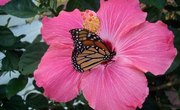What is the importance of flowers in nature? Besides adding color, texture and biodiversity to gardens and ecosystems, flowers are botanically important structures and essential sources of food for many organisms. The flower is an important means of attracting pollinators to a plant, which is necessary in order for the plant to produce seeds, reproductive structures that allow a species to exist generation after generation. Flowers also protect seeds as they develop, ensuring the successful transfer of genetic material to the next generation. Plants that make flowers are called angiosperms, and they are a group that has evolved to encompass a wide range of diversity in size, form and color.
Value of Flowers
The main function of flowers is to attract pollinators to plants to ensure the reproduction and survival of the plant species. Many plants and pollinators have adapted characteristics to ensure a mutually beneficial relationship for each organism. Just as plants rely on bees, bats, moths and hummingbirds for help pollinating their flowers, these species depend on nectar and pollen from flowers for nutrition.
For instance, some flowers produce two types of pollen: one for pollination, and one to feed pollinators. Other flowers have intricate designs on their petals called nectar guides to help pollinators find the pollen within their flowers. The color, shape and fragrance of most flowers has evolved over thousands of years to benefit both the plant species and the pollinators that visit that flower.
The importance of flowers in nature cannot be overstated. Without flowers, there would be no fruit, grains, nuts or berries, as these are the ripened products of a successfully fertilized flower. These foods that are critical sources of calories and nutrients for a wide variety of organisms help support the biodiversity of our planet.
Uses of Flowers
About 90 percent of plant species produce flowers. Flowers are essential reproductive structures of angiosperms and important food sources for many insects and animals – and flowers also have been valued by humans for thousands of years for a variety of reasons.
Flowers are cultivated in arrangements, gardens and landscapes for their aesthetic appeal. Many flowers are also used medicinally, such as chamomile and Saint John's wort. Still others are used to garnish foods; edible flowers include calendula, nasturtiums and mints.
Studies have shown that flowers impact happiness, help connect people and increase feelings of kindness and compassion. Flowers have the power to lift moods, decrease depression and improve creative performance. Clearly, flowers are important in nature – and to humans – in many different ways.
Economic Importance of Flowers
Most of the food that humans, insects and animals eat comes from angiosperms, or plants that make flowers. Vegetables like peas, tomatoes, peppers, sweet corn and broccoli are produced by angiosperms. Grains such as wheat, rice, barley, oats and rye are products of angiosperms, and fruits like apples, oranges and bananas all come from flowering plants too.
Even plants grown to feed livestock often make flowers. Forage crops such as soybeans, clovers, alfalfas and vetches are all flowering plants. Most of the flowering plants that are grown for food, forage and fiber are bought and sold internationally, and our global economic markets are based on the trading of goods that are related directly to the production of flowering plants.
The world as we know it depends largely on the success and healthy growth of angiosperms, or flowering plants. Many of the foods you eat every day rely on help from pollinators like bees to produce abundant crops; in fact, according to some estimates, one in three bites of food you eat is made possible due to the work of a pollinator. So, next time you enjoy a crunchy bite of an apple or a juicy tomato, take time to thank both the flower and the pollinator that made that food possible!
References
About the Author
Meg Schader is a freelance writer and copyeditor. She holds a Bachelor of Science in agriculture from Cornell University and a Master of Professional Studies in environmental studies from SUNY College of Environmental Science and Forestry. Along with freelancing, she also runs a small farm with her family in Central New York.
